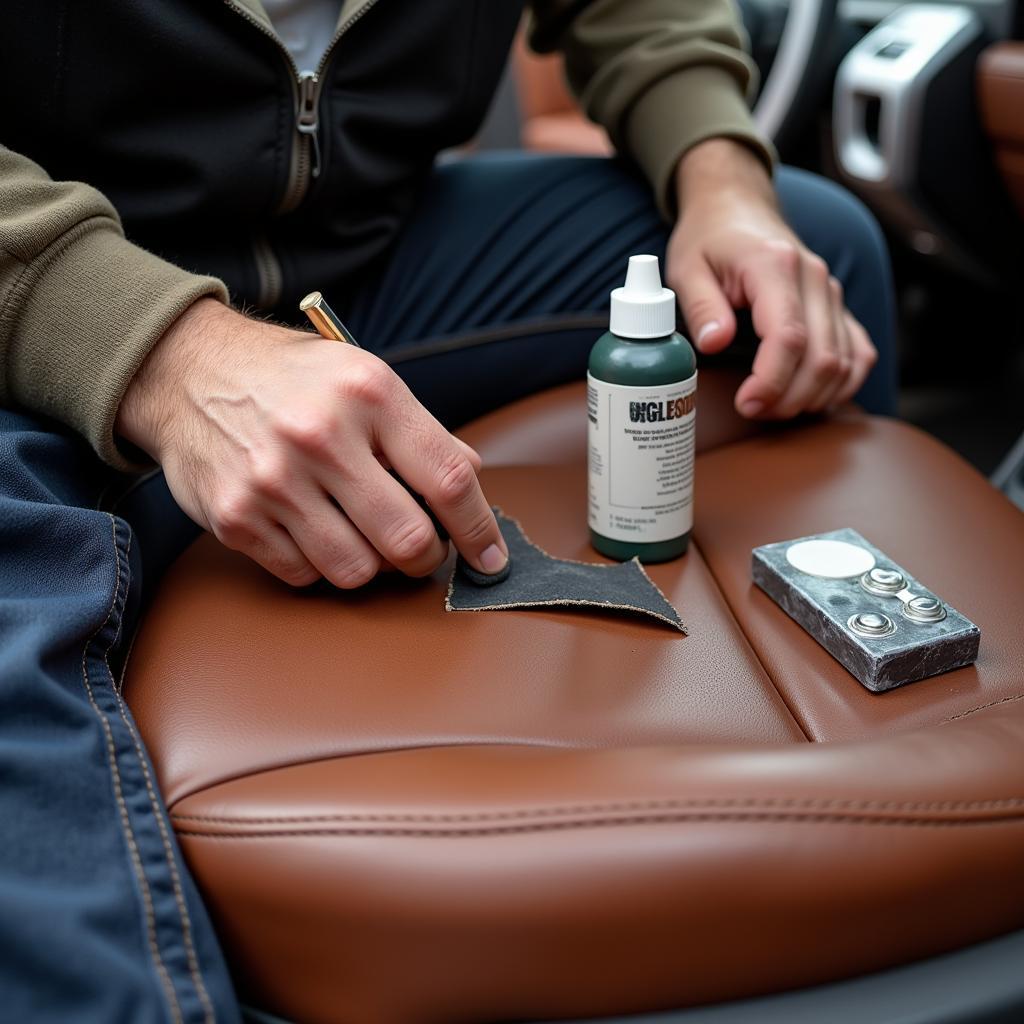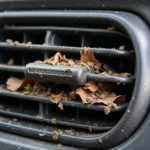Old car seats can make even the most luxurious vehicle feel tired and worn out. But before you consider replacing those seats, you might be surprised at how a little TLC can bring them back to life. This guide will walk you through the steps and techniques to repair old car seats, whether they are leather, vinyl, or cloth.
 Repairing a Torn Leather Car Seat
Repairing a Torn Leather Car Seat
Identifying the Damage: The First Step to Repair
Before you begin, it’s crucial to assess the type and extent of damage your car seats have endured.
- Cracks and Tears: Common in leather and vinyl seats due to age, sun exposure, and wear and tear.
- Fading and Discoloration: Often caused by prolonged exposure to sunlight.
- Stains and Spills: Food, drinks, and everyday grime can leave their mark.
- Wear and Tear on the Bolsters: The raised areas on the sides of the seats tend to show wear first.
- Sagging and Loss of Support: This is typical in older cars where the seat padding has compressed over time.
Essential Tools and Materials for Car Seat Repair
Having the right tools and materials on hand can make your car seat repair project much smoother. Here’s a list to get you started:
- Cleaning Supplies: A good quality car seat cleaner, microfiber cloths, and a soft-bristled brush are essential for prepping the surface.
- Repair Kits: Leather, vinyl, and cloth repair kits are readily available and cater to specific materials and damage types. These kits often include patches, fillers, adhesives, and color-matching compounds.
- Sewing Supplies: For cloth seat repairs, you’ll need a needle, thread, and possibly a curved upholstery needle for reaching tight spots.
- Heat Gun or Hairdryer: Helpful for setting leather and vinyl repairs and for speeding up drying times.
- Sharp Scissors: For precise cutting of patches and materials.
Tackling Common Car Seat Repairs: Step-by-Step
Now that you’ve identified the damage and gathered your supplies, let’s dive into some common car seat repair techniques:
How to Repair Cracks in Leather Car Seats
- Clean the Area: Thoroughly clean the cracked area with a leather cleaner and a soft-bristled brush to remove any dirt or debris.
- Fill the Crack: Use a leather filler compound, applying it with a palette knife or spreader. Overfill the crack slightly to allow for shrinkage during drying.
- Level and Smooth: Carefully level the filler with the surface of the seat, using a damp cloth to smooth out any imperfections.
- Apply Leather Dye (If Needed): If the crack is deep or the color match isn’t perfect, use a leather dye that matches your seat color. Apply thin coats, allowing each layer to dry completely.
- Apply Leather Conditioner: Once the repair is dry, apply a leather conditioner to restore moisture and suppleness.
How to Repair Tears in Cloth Car Seats
- Clean the Area: Gently vacuum or brush the torn area to remove any loose threads or debris.
- Trim Excess Threads: Use sharp scissors to carefully trim any loose or frayed threads around the tear.
- Apply Patching Material (If Needed): For larger tears, you may need to use a patch. Iron-on patches designed for fabric work well, or you can use a piece of similar fabric secured with fabric glue.
- Stitch the Tear: Using a needle and thread that closely matches the color of your car seat fabric, carefully stitch the tear closed. A slip stitch or ladder stitch works well for a discreet repair.
[how to repair old torn leather car seats](https://carrepairon.com/how to repair old torn leather car seats/)
How to Repair Cigarette Burns in Car Seats
- Assess the Damage: Cigarette burns can vary in severity. If the burn has gone through the seat cover, a replacement or professional repair may be necessary.
- Clean the Area: Gently clean the area around the burn with a mild cleaner suitable for your seat material.
- Use a Filler Compound: For minor burns, a vinyl or leather filler compound can be used to fill the hole. Apply it sparingly and blend it in with a damp cloth.
- Color Matching (If Needed): If the filler doesn’t perfectly match your seat color, use a matching dye or paint to camouflage the repair.
[how to repair cigarette burns in car seats](https://carrepairon.com/how to repair cigarette burns in car seats/)
Beyond DIY: When to Consult a Professional
While many car seat repairs can be tackled at home, some situations warrant the expertise of a professional upholsterer.
- Extensive Damage: If the damage to your car seats is widespread or severe, such as large tears, deep burns, or significant structural issues, it’s best to seek professional help.
- Airbag Concerns: If the damage is near an airbag seam or you’re unsure if the airbag system has been compromised, consult a professional to avoid interfering with safety features.
- Lack of Confidence: If you’re not confident in your ability to repair the damage yourself, a professional can ensure a high-quality and long-lasting repair.
Maintaining Your Repaired Car Seats: Tips for Longevity
Once you’ve put in the effort to repair your car seats, it’s essential to protect your investment and keep them looking their best:
- Regular Cleaning: Make it a habit to clean your car seats regularly with a product designed for your seat material. This will prevent dirt and grime from becoming embedded and causing premature wear.
- UV Protection: Prolonged exposure to sunlight can fade and damage your car seats. Use a sunshade or window tint to block harmful UV rays, especially if you park your car outdoors frequently.
- Seat Covers: Consider using seat covers to provide an extra layer of protection against spills, stains, and wear and tear. Choose breathable materials that won’t trap heat and moisture.
[how to repair discolored leather car seats](https://carrepairon.com/how to repair discolored leather car seats/)
Conclusion: Breathe New Life into Your Old Car Seats
Repairing old car seats can be a rewarding DIY project that saves you money and enhances the overall look and feel of your vehicle. By following the steps and tips outlined in this guide, you can tackle those cracks, tears, and blemishes and give your car’s interior a well-deserved refresh. Remember, a little maintenance goes a long way in preserving the life and comfort of your car seats for years to come.
[can a vw golf leather car seat be repaired](https://carrepairon.com/can a vw golf leather car seat be repaired/)
FAQs
1. Can I use super glue to repair a tear in my car seat?
It’s not recommended. Super glue can create a stiff bond that’s prone to cracking and may damage the surrounding fabric or leather.
2. How long does it take for leather filler to dry?
Drying times vary depending on the product, but most leather fillers take 24-48 hours to cure completely.
3. Can I dye my cloth car seats a different color?
Dyeing cloth car seats is tricky and often yields uneven results. It’s best to consult a professional for color changes.
4. How can I prevent my leather seats from cracking in the future?
Regularly cleaning and conditioning your leather seats will help keep them supple and prevent cracking.
5. Where can I find matching fabric for a cloth seat repair?
You can sometimes find matching or similar fabric at fabric stores, online retailers, or by contacting the car manufacturer.
Need Expert Assistance with Your Car Seat Repair?
We’re here to help! Contact our team of experienced automotive professionals for expert advice, customized solutions, and top-notch repair services.
WhatsApp: +1(641)206-8880
Email: [email protected]
We offer 24/7 support to answer your questions and assist you with all your car repair needs.


